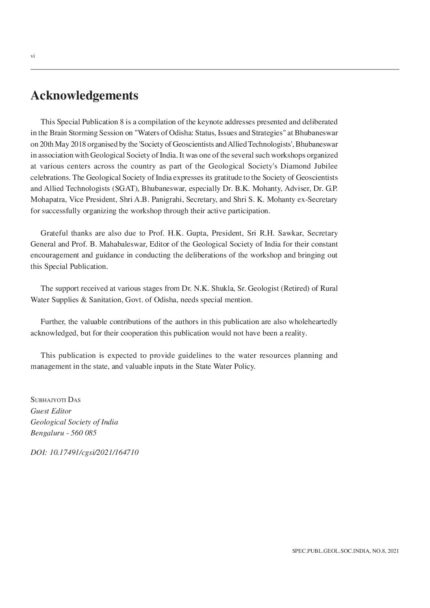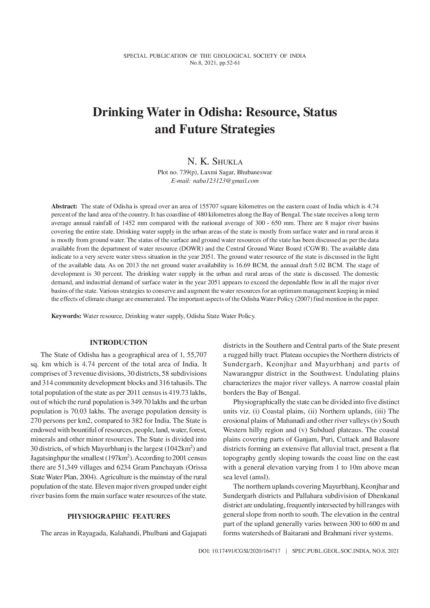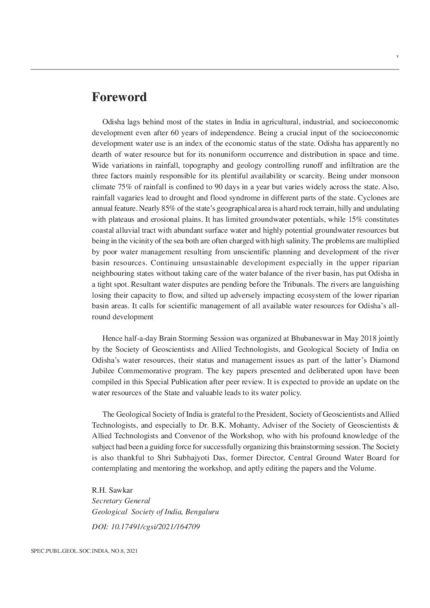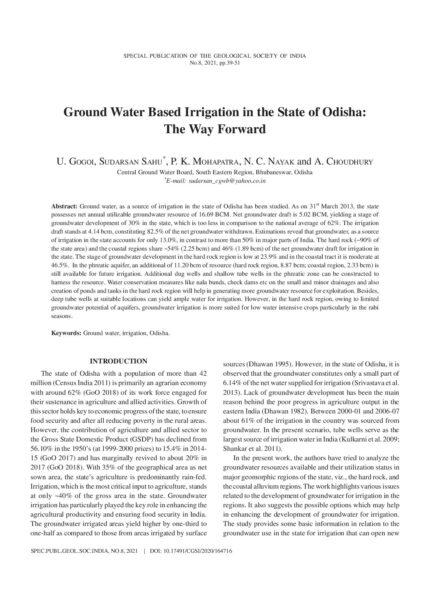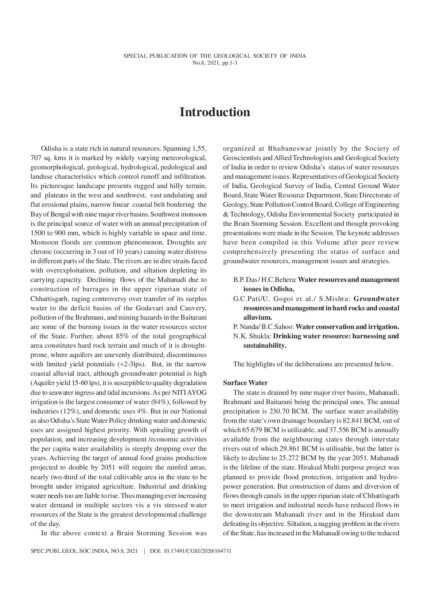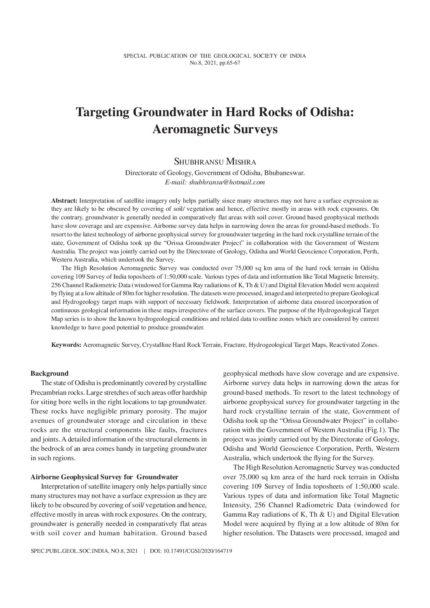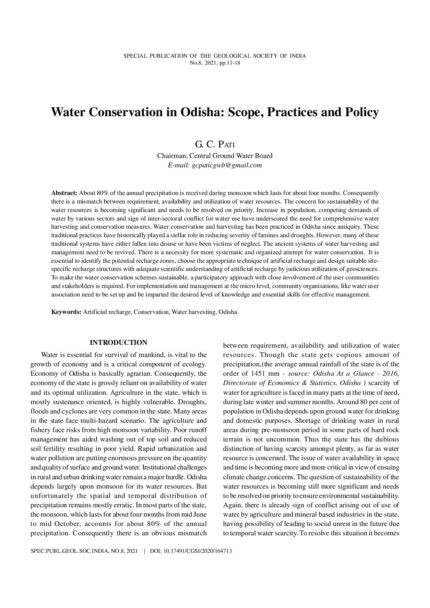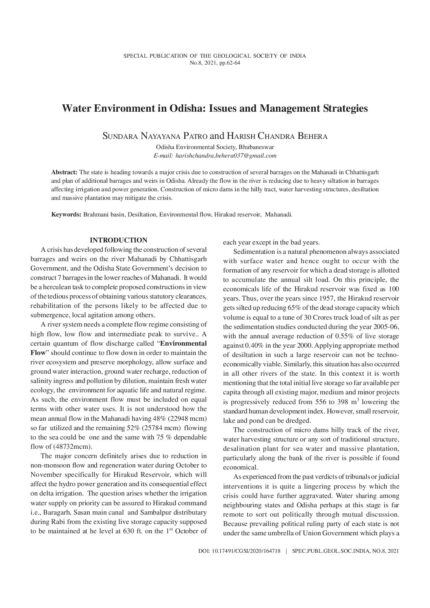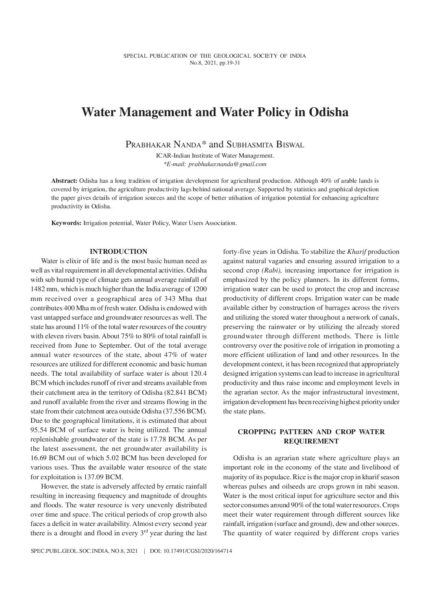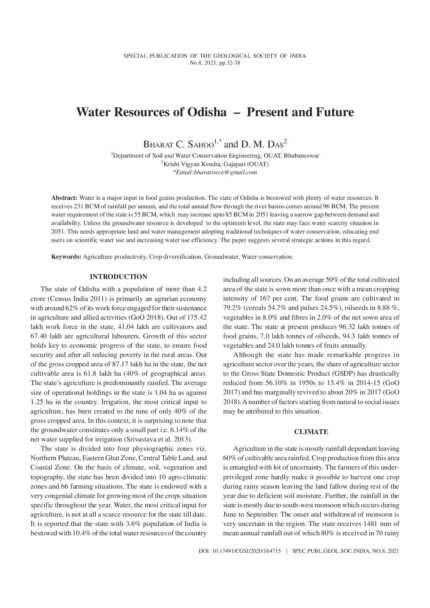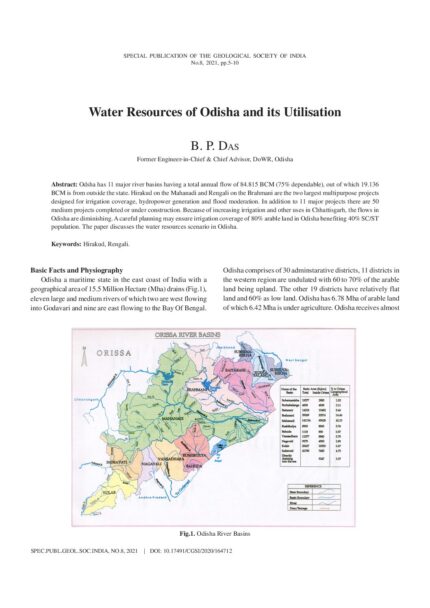SP-08: Water Resources of Odisha: Status
Drinking Water in Odisha: Resource, Status and Future Strategies
SKU:
C-164717
The state of Odisha is spread over an area of 155707 square kilometres on the eastern coast of India which is 4.74 percent of the land area of the country. It has coastline of 480 kilometres along the Bay of Bengal. The state receives a long term average annual rainfall of 1452 mm compared with the national average of 300 - 650 mm. There are 8 major river basins covering the entire state. Drinking water supply in the urban areas of the state is mostly from surface water and in rural areas it is mostly from ground water. The status of the surface and ground water resources of the state has been discussed as per the data available from the department of water resource (DOWR) and the Central Ground Water Board (CGWB). The available data indicate to a very severe water stress situation in the year 2051. The ground water resource of the state is discussed in the light of the available data. As on 2013 the net ground water availability is 16.69 BCM, the annual draft 5.02 BCM. The stage of development is 30 percent. The drinking water supply in the urban and rural areas of the state is discussed. The domestic demand, and industrial demand of surface water in the year 2051 appears to exceed the dependable flow in all the major river basins of the state. Various strategies to conserve and augment the water resources for an optimum management keeping in mind the effects of climate change are enumerated. The important aspects of the Odisha Water Policy (2007) find mention in the paper.
Ground Water Based Irrigation in the State of Odisha: The Way Forward
SKU:
C-164716
Ground water, as a source of irrigation in the state of Odisha has been studied. As on 31sta March 2013, the state possesses net annual utilizable groundwater resource of 16.69 BCM. Net groundwater draft is 5.02 BCM, yielding a stage of groundwater development of 30% in the state, which is too less in comparison to the national average of 62%. The irrigation draft stands at 4.14 bcm, constituting 82.5% of the net groundwater withdrawn. Estimations reveal that groundwater, as a source of irrigation in the state accounts for only 13.0%, in contrast to more than 50% in major parts of India. The hard rock (?90% of the state area) and the coastal regions share ?54% (2.25 bcm) and 46% (1.89 bcm) of the net groundwater draft for irrigation in the state. The stage of groundwater development in the hard rock region is low at 23.9% and in the coastal tract it is moderate at 46.5%. In the phreatic aquifer, an additional of 11.20 bcm of resource (hard rock region, 8.87 bcm; coastal region, 2.33 bcm) is still available for future irrigation. Additional dug wells and shallow tube wells in the phreatic zone can be constructed to harness the resource. Water conservation measures like nala bunds, check dams etc on the small and minor drainages and also creation of ponds and tanks in the hard rock region will help in generating more groundwater resource for exploitation. Besides, deep tube wells at suitable locations can yield ample water for irrigation. However, in the hard rock region, owing to limited groundwater potential of aquifers, groundwater irrigation is more suited for low water intensive crops particularly in the rabi seasons.
Targeting Groundwater in Hard Rocks of Odisha: Aeromagnetic Surveys
SKU:
C-164719
Interpretation of satellite imagery only helps partially since many structures may not have a surface expression as they are likely to be obscured by covering of soil/ vegetation and hence, effective mostly in areas with rock exposures. On the contrary, groundwater is generally needed in comparatively flat areas with soil cover. Ground based geophysical methods have slow coverage and are expensive. Airborne survey data helps in narrowing down the areas for ground-based methods. To resort to the latest technology of airborne geophysical survey for groundwater targeting in the hard rock crystalline terrain of the state, Government of Odisha took up the ?Orissa Groundwater Project? in collaboration with the Government of Western Australia. The project was jointly carried out by the Directorate of Geology, Odisha and World Geoscience Corporation, Perth, Western Australia, which undertook the Survey.The High Resolution Aeromagnetic Survey was conducted over 75,000 sq km area of the hard rock terrain in Odisha covering 109 Survey of India toposheets of 1:50,000 scale. Various types of data and information like Total Magnetic Intensity, 256 Channel Radiometric Data (windowed for Gamma Ray radiations of K, Th & U) and Digital Elevation Model were acquired by flying at a low altitude of 80m for higher resolution. The datasets were processed, imaged and interpreted to prepare Geological and Hydrogeology target maps with support of necessary fieldwork. Interpretation of airborne data ensured incorporation of continuous geological information in these maps irrespective of the surface covers. The purpose of the Hydrogeological Target Map series is to show the known hydrogeological conditions and related data to outline zones which are considered by current knowledge to have good potential to produce groundwater.
Water Conservation in Odisha: Scope, Practices and Policy
SKU:
C-164713
About 80% of the annual precipitation is received during monsoon which lasts for about four months. Consequently there is a mismatch between requirement, availability and utilization of water resources. The concern for sustainability of the water resources is becoming significant and needs to be resolved on priority. Increase in population, competing demands of water by various sectors and sign of inter-sectoral conflict for water use have underscored the need for comprehensive water harvesting and conservation measures. Water conservation and harvesting has been practiced in Odisha since antiquity. These traditional practices have historically played a stellar role in reducing severity of famines and droughts. However, many of these traditional systems have either fallen into disuse or have been victims of neglect. The ancient systems of water harvesting and management need to be revived. There is a necessity for more systematic and organized attempt for water conservation. It is essential to identify the potential recharge zones, choose the appropriate technique of artificial recharge and design suitable sitespecific recharge structures with adequate scientific understanding of artificial recharge by judicious utilization of geosciences. To make the water conservation schemes sustainable, a participatory approach with close involvement of the user communities and stakeholders is required. For implementation and management at the micro level, community organisations, like water user association need to be set up and be imparted the desired level of knowledge and essential skills for effective management.
Water Environment in Odisha: Issues and Management Strategies
SKU:
C-164718
The state is heading towards a major crisis due to construction of several barrages on the Mahanadi in Chhattisgarh and plan of additional barrages and weirs in Odisha. Already the flow in the river is reducing due to heavy siltation in barrages affecting irrigation and power generation. Construction of micro dams in the hilly tract, water harvesting structures, desiltation and massive plantation may mitigate the crisis.
Water Management and Water Policy in Odisha
SKU:
C-164714
Odisha has a long tradition of irrigation development for agricultural production. Although 40% of arable lands is covered by irrigation, the agriculture productivity lags behind national average. Supported by statistics and graphical depiction the paper gives details of irrigation sources and the scope of better utilsation of irrigation potential for enhancing agriculture productivity in Odisha.
Water Resources of Odisha ? Present and Future
SKU:
C-164715
Water is a major input in food grains production. The state of Odisha is bestowed with plenty of water resources. It receives 231 BCM of rainfall per annum, and the total annual flow through the river basins comes around 96 BCM. The present water requirement of the state is 55 BCM, which may increase upto 85 BCM in 2051 leaving a narrow gap between demand and availability. Unless the groundwater resource is developed to the optimum level, the state may face water scarcity situation in 2051. This needs appropriate land and water management adopting traditional techniques of water conservation, educating end users on scientific water use and increasing water use efficiency. The paper suggests several strategic actions in this regard.
Water Resources of Odisha and its Utilisation
SKU:
C-164712
Odisha has 11 major river basins having a total annual flow of 84.815 BCM (75% dependable), out of which 19.136 BCM is from outside the state. Hirakud on the Mahanadi and Rengali on the Brahmani are the two largest multipurpose projects designed for irrigation coverage, hydropower generation and flood moderation. In addition to 11 major projects there are 50 medium projects completed or under construction. Because of increasing irrigation and other uses in Chhattisgarh, the flows in Odisha are diminishing. A careful planning may ensure irrigation coverage of 80% arable land in Odisha benefiting 40% SC/ST population. The paper discusses the water resources scenario in Odisha.

